Propagating Figs Through Hardwood Cuttings
go.ncsu.edu/readext?1050980
en Español / em Português
El inglés es el idioma de control de esta página. En la medida en que haya algún conflicto entre la traducción al inglés y la traducción, el inglés prevalece.
Al hacer clic en el enlace de traducción se activa un servicio de traducción gratuito para convertir la página al español. Al igual que con cualquier traducción por Internet, la conversión no es sensible al contexto y puede que no traduzca el texto en su significado original. NC State Extension no garantiza la exactitud del texto traducido. Por favor, tenga en cuenta que algunas aplicaciones y/o servicios pueden no funcionar como se espera cuando se traducen.
Português
Inglês é o idioma de controle desta página. Na medida que haja algum conflito entre o texto original em Inglês e a tradução, o Inglês prevalece.
Ao clicar no link de tradução, um serviço gratuito de tradução será ativado para converter a página para o Português. Como em qualquer tradução pela internet, a conversão não é sensivel ao contexto e pode não ocorrer a tradução para o significado orginal. O serviço de Extensão da Carolina do Norte (NC State Extension) não garante a exatidão do texto traduzido. Por favor, observe que algumas funções ou serviços podem não funcionar como esperado após a tradução.
English
English is the controlling language of this page. To the extent there is any conflict between the English text and the translation, English controls.
Clicking on the translation link activates a free translation service to convert the page to Spanish. As with any Internet translation, the conversion is not context-sensitive and may not translate the text to its original meaning. NC State Extension does not guarantee the accuracy of the translated text. Please note that some applications and/or services may not function as expected when translated.
Collapse ▲If you are itching to get in the garden despite the cool weather, Gates County Extension Master Gardener Volunteer Cynthia Wagoner has a propagation project that can be done at almost any time. Cynthia is originally from Ohio and often writes about her experiences and gaining garden knowledge as a “transplant” to the more southern states.
______________________________________________________________________________________
Buckeye Discoveries: Propagating Fig Trees
Written By Cynthia S. Wagoner, Extension Mater Gardener Volunteer
In 1975 in Norfolk, Virginia, I saw a fig tree for the very first time and tasted the fruit. At this point in time, I had only experienced fig newtons, and never had a fresh fig. I was hook. In the ensuing years, I learned more about figs and how to grow them After becoming an Extension Master Gardener Volunteer, I learned how to propagate them, giving the saplings to friends and neighbors. Below are several methods on how to propagate fig trees yourself
Method #1
1. Take cuttings in January through April approximately 6 inches long.
2. Dip in rooting hormone. (Available at gardening centers)
3. Put cutting in seed starting soil mix in small pots.
4. Put into a greenhouse-like environment until leaves sprout. Must have high humidity. I use a plastic tub with lid and keep in a sunny location inside my house.
5. After roots emerge, plant in larger pots and put in shade outside. It could take 3 to 6 weeks before ready to transplant to larger pots after roots have developed.
6. In the fall, plant in the ground at permanent location.

Fig Hardwood cuttings can be placed inside of a clear tote in a sunny location to help maintain humidity for root formation.
Method #2
Using paper towels and a bag.
Very easy!
1.Simply cut 6 inch stems in early spring, wrap the bottoms in moist paper towels
individually, and place in plastic bag.
2. Place on top of refrigerator (or other area for warmth) and check
periodically. May take three to six weeks to see roots emerge.
3. After roots emerge, plant
in small pots outdoor in the shade, watering frequently.
4.Plant in their permanent location in the fall.
Method #3
Easiest yet!
Take six to eight inch cuttings and place in vase of water. When roots emerge, plant as above in Method #2 and continue with instructions.
Keep in mind that not all cuttings will root and become trees! About 75% should take root; however.




